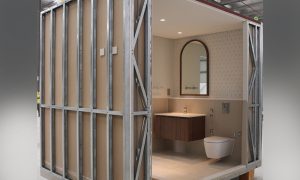What BIM is not…
A clear understanding of Building Information Management (BIM) and its objectives in relation to a project is crucial to tapping its full potential

While BIM or Building Information Management is winning new advocates in the infrastructure sector, there still remains a fair bit of confusion on what it actually stands for — a technology or a product or a concept?
There is a general agreement that BIM is an evolving technology, which deals with new and innovative ways of approaching design and documentation information during the different stages of building.
“When we say building, we refer to it as a continuous verb rather than a physical asset,” explained Nader Reslan, Manager for the Rail Sector, Bentley Systems. “BIM embraces the entire lifecycle of the building process beyond the initial design phase to include build, operations and maintenance phases.”
Reslan pointed out that BIM is not a product, data format or vendor-specific initiative. Nor should it be confused with a massive 3D CAD model, GIS model or a hybrid of both.
He said: “It is a process which must be understood by the people involved and supported by IT systems and solutions in that process.”
Reslan cited the example of Crossrail, a Bentley client in the UK, which was clear about adopting BIM as a process right from the beginning.
Crossrail wanted to ensure better project performance during initial and detailed design, construction, and post-completion, have a complete BIM model in hand for Operations & Maintenance (O&M).
“At Crossrail, they put in the right procedures and processes and the desired standards,” said Reslan. “Of course, you do put in new processes in any new project but with BIM, you can put them into a type of framework together with the technology to control them.”
In a rail project, BIM can capture all the design parameters during construction, and ensure that all the changes to the lines, alignments and stations are captured so that when the O&M stage arrives, the client has a fully enriched and informed model.
In Crossrail’s case, they not only persuaded their entire supply chain to adopt BIM, but also took steps to make the adoption as easy and affordable as possible, which helped overcome the anticipated resistance from different stakeholders and teams.
According to Reslan, by insisting on the use of BIM right from the planning stage, the project owner can ensure that the information is mobile as the project moves from one phase to another — from design to construction to O&M — and is available to different stakeholders within that phase.
The model can also be kept up-to-date with all the information, standards and specifications and more important, the occasional changes to the original design that happen during the construction, or to the equipment during the O&M stages.
Reslan said: “This saves them the trouble of doing re-engineering or resurveying when moving between the phases or when a new stakeholder comes into the picture or even when the infrastructure ownership changes hands.
You not only end up with the physical infrastructure but also its equivalent digital infrastructure. With BIM, you can integrate all the information in one model in one place, which is the ultimate goal for the project-owner.”
In the real world, a contractor or consultant or supplier may look at BIM as a ‘client solution.’ According to Reslan, while BIM should be applied by these stakeholders during the project, the project-owner will always remain the ultimate stakeholder of this integrated model.
From a top management standpoint, some of the key benefits of implementing BIM are avoiding major design conflicts, smoother management of documents, designs and models between the stakeholders, and efficient and quicker contract administration.
The integrated and well-coordinated environment made possible through BIM can be used to create executive dashboards that display the process and the progress of this information. For Reslan, the advantages of making BIM mandatory for projects are several. For example, at the conclusion of any infrastructure project, an electronic handover of drawings — 2D and 3D CAD, Shop drawings — is part of the delivery. If BIM is already in place, all these drawings can be easily extracted from the BIM model.
But it is equally important that the client has the necessary set-up, to not only receive the BIM model but also utilise it to its full potential.
Reslan said: “You can specify a BIM model to be as enriched as possible on delivery, but you need to strike a balance because a fully detailed BIM model that you will never use is as much a waste as a fancy 3D model to impress your superiors.”



















